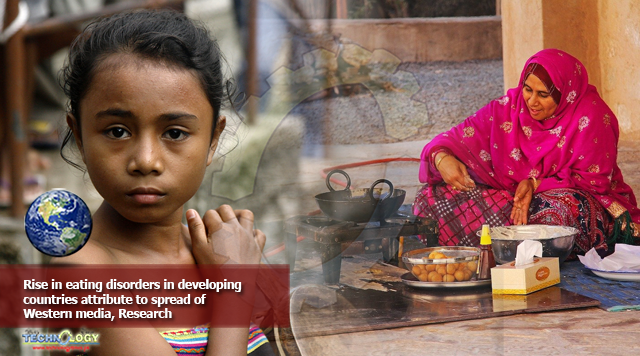While there are stereotypes that eating disorders affect only white middle-class women in Western societies. In reality, these disorders are a global issue.

Since the 1990s, there was a rise in eating disorders in developing countries, which many researchers attribute to the spread of Western media and beauty ideals.
Due to the access to television and media, many developing countries have adopted these views of thinness equating to beauty. This is in addition to social media, which idealizes thin figures across different platforms and condemns larger figures.
These standards put more people at risk of an eating disorder. Individuals in more impoverished countries can fall victim to these disordered ideas and habits just as easily.
One notable example of eating disorders in developing countries is Fiji. Previous to the spread of Western media, Fiji’s notion of female beauty “was a heavier, rounder and softer” shape.
However, after the introduction of Western television and media in the late 1990s, the rate of eating disorders increased dramatically. Risk factors for eating disorders became more prevalent, including dieting, body dissatisfaction and disordered eating habits.
Eating Disorders in the Middle East
Many often overlook the Middle East when it comes to eating disorders, especially since many countries in the region are a part of the third world. This has resulted in very little data on the rate of eating disorders despite their growing presence in the region.
The Middle East Eating Disorders Association conducted a study in the United Arab Emirates that found that college students “who had a higher awareness of eating disorders had a higher rate of developing them.”
The president of the Israeli Association for food Disorders commented that anorexia and bulimia nervosa in Israel are just as prevalent as in Western nations. She said the rise of eating disorders is likely due to the presence of social media. This has made it easier for people to compare “themselves to images posted online.”
Many researchers overlook eating disorders in the region despite studies confirming their growing presence because these countries face larger threats of poverty and famine compared to first world countries.
In Pakistan, one study found that girls in Pakistan who had a larger exposure to Western media and television were at greater risk of developing an eating disorder. While many of the women admitted to being dissatisfied with their bodies, only 20% were actually above the normal weight.
Many of these women said that their body dissatisfaction was inspired by the bodies of Indian and white actresses they admired in television and media. They also referred to the Miss Universe pageants.
Eating Disorders in Africa
A 2016 study observing eat disorder in Africa provided some much-needed data in areas that researchers often ignore. Among the sample of 1,476 females, this study found that none of the women fit the criteria of anorexia nervosa.
However, the rate of bulimia nervosa was 0.87% and the rate of EDNOS (eating disorder not otherwise specified) was 4.45%. The rate of women suffering from bulimia was on par with that of Western populations and Latin American countries.
One study specifically analyzed the issue in East Africa with a sample size of 214 Tanzanian women. More than a third of these women expressed discontentment with their body image with 20.9% fearing weight gain.
Media exposure was common for half of these women, showing some correlation between disordered eat and media exposure. Eating disorders were on the rise in South Africa in 2016.
Researchers noticed that this correlated with the country’s rapid rate of urbanization and development. Researchers believe that the contrast between Western and South African culture can impact an individual’s sense of identity and body image.
Changing the Negative Image
Overall, eating disorders in developing countries often go unrecognized because of the stigma surrounding them and the lack of research. Within these different regions, many have worked to make an impact on this issue.
- In the Middle East, a student in Oman named Zainab al-Balushi is currently making a skin patch that delivers nutrients to those in the late stages of eating disorders. In testing her prototype, she found mice were able to successfully absorb Vitamin D and folic acid. This invention would help those with anorexia nervosa who are suffering from malnutrition. Once her clinical trials are approved, she intends to apply this treatment in outpatient programs for eating disorders.
- Local organizations in the Middle East are helping those suffering in Islamic states. The organization Islam and Eating Disorders provides assistance and resources mainly through offering counseling services and online recovery forums. The Middle East Eating Disorders Association (MEEDA) also raises awareness through eating disorders in the region, conducts research on the topic and collaborates with other associations to provide free support groups.
- In South Africa, there are online forums such as EDSA and RecoverySpace.org that offer support groups and treatment referrals. EDSA hosts weekly support groups for those suffering from anorexia or bulimia nervosa. RecoverySpace.org offers referrals for treatment ranging from inpatient care to support groups.
- The Global Foundation for Eat Disorder is an organization of business leaders, researchers, clinicians and scientists who work to eliminate eating disorders through academic research around the world. The foundation funds research in renowned institutions such as Harvard, Stanford and Duke University that work to improve treatment and solutions for those suffering from eating disorders.
In developing and impoverished countries many people suffer from extreme body dissatisfaction that can lead to disordered eating. It is necessary to promote more awareness in these countries and conduct more research that can quantify the issue.
The same resources and treatment that Western countries have must be available in developing countries. With awareness and resources, those suffering from eating disorders in developing countries will have the support they need for a steady recovery.
Originally published at Borgen magazine